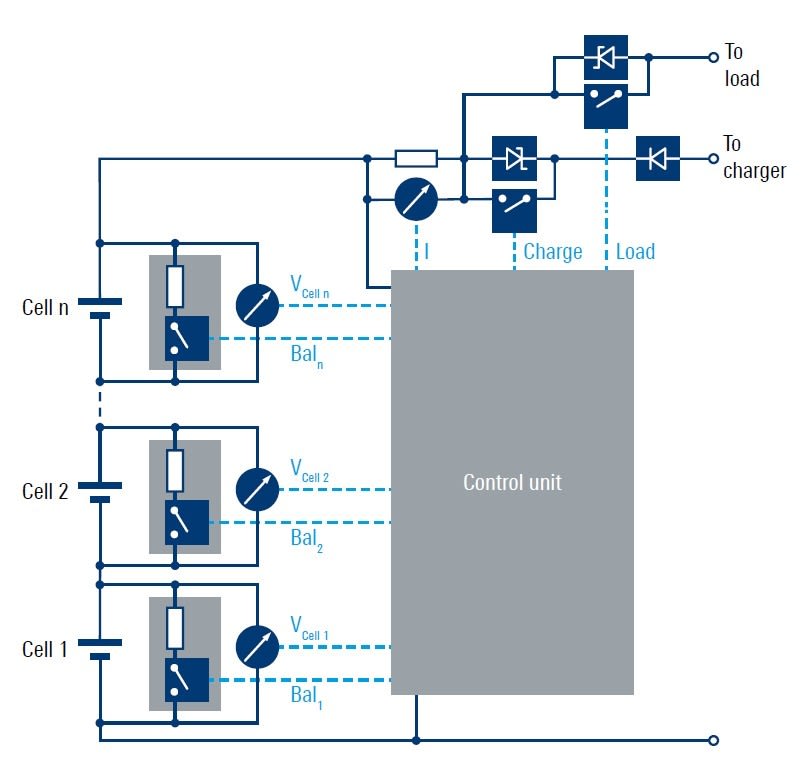Testing battery management systems (BMS) with R&S power supplies
Follow articleHow do you feel about this article? Help us to provide better content for you.
Thank you! Your feedback has been received.
There was a problem submitting your feedback, please try again later.
What do you think of this article?
The importance of battery lifetime
Rechargeable batteries used in battery-powered devices and vehicles need to be stimulated, measured and tested. Overcharging and deep discharging reduce the lifetime of rechargeable batteries. Defects could lead to overheating of a battery and even cause a fire.
Larger batteries are typically built by connecting multiple cells in series and parallel. Since the same charge and discharge current flows through all cells, individual differences in battery capacity, self-discharging, etc. would lead to differing states of charge over time and consequently limit the capacity and lifetime of the battery.
The need for BMS
So-called battery management systems play a crucial role in battery life and fail-safety. Such systems actively monitor, control and manage various battery cell parameters. Among others, a BMS is responsible for the following tasks:
- Determining the stage of charge of each cell
- Supervising the integrity and derating of each cell (state of health)
- Detecting faults and exceptional conditions and preventing hazards such as overheating and fire
- Balancing the stage of charge between the cells, which can be implemented in a passive way by selectively loading the cells
- Thermal and energy management
Schematic of a battery pack with a BMS
Testing BMSs with R&S solutions
Because of their great importance, BMSs need to be tested thoroughly. Such tests have to simulate all conditions that could possibly occur in operation.
Rohde & Schwarz offers two speciality power supplies that are tailored to specific applications and have unique capabilities such as emulating the characteristics of a battery. The versatile R&S®NGL200 (184-9489) and R&S®NGM200 (193-8370) DC power supplies are equipped with all functions needed to test and validate BMSs. Because of their advantageous capability to simulate battery cells, they can replace far more expensive dedicated battery simulators.
Both solutions support two-quadrant operation as source and sink. Source currents up to 6 A and sink currents up to 3 A are possible. All outputs are fully isolated against ground. They can be connected in series to emulate battery packs on a single cell level up to a maximum voltage of 250 V against ground. The adjustable output impedance can be set between –50 mΩ and 100 Ω. Current and voltage measurements at the power supply output deliver high-resolution values. Their two channels per unit and compact form factor allow flexible configuration and space-saving setups for testing a BMS. A 19" rackmount kit and backplane connections provide easy and rugged integration into racks.
Battery simulation option, measurement accuracy & fast logging
All functions can be fully remote controlled with command processing times of less than 6 ms. In addition, the R&S®NGM200 power supply series features an optional battery simulation mode that allows realistic simulation of different predefined or user-defined cell types. Open-circuit voltage and internal resistance depending on the state of charge are defined for each cell type in an ASCII file.
These features allow the cell properties to be simulated and varied over time with high precision and high time resolution. For small and medium-sized batteries, the cell current can be drawn directly out of the power supplies. For larger batteries like those used in automotive applications, it is not necessary for the charging and discharging currents to physically flow for the BMS tests. Current measurement results, e.g. voltages across shunt resistors, are simulated to the BMS, and the power supplies establish the cell voltages and deliver the balancing currents.
Beyond the battery simulation option, the R&S®NGM200 power supply series provides enhanced measurement accuracy and fast logging of current and voltage up to a sample rate of 500 000 values per second. The battery simulation option can run profiles stored in ASCII files; these profiles describe the open-circuit voltage and internal resistance versus state of charge. Profiles for common battery types are available in the power supply. The fast logging function can capture narrow spikes and glitches in current and voltage for troubleshooting purposes.


